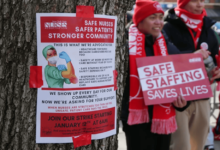Drug and alcohol workforce plan highlights ‘essential’ nurse role

The role of the nurse is “particularly suited” to working in drug and alcohol services but more needs to be done to make the field attractive to the profession, according to a new major workforce plan.
The government and NHS England have today published the first-ever national strategic workforce plan for the drug and alcohol treatment and recovery sector, covering 2024 to 2034.
“Offering placements to post-registered nurses can provide nurses with an opportunity to learn more about working in the sector”
Workforce plan
The plan aims to help organisations meet previously set workforce expansion targets as well as improve recruitment and retention for these services in the longer term.
Nurses currently make up around 9% of the drug and alcohol treatment and recovery workforce but employers face difficulties in recruiting new nurses and retaining those in their teams, said the plan.
It stated: “Nurses play an essential role in the care and treatment of people who use(d) drugs and/or alcohol as their training encompasses both physical and mental health and places it in the context of community health. This makes them particularly suited to the drug and alcohol treatment and recovery sector.
“The diverse mental and physical healthcare needs of the treatment population require specialist nursing input and, as such, the sector has the potential for ample career development opportunities. Despite this, stakeholders reported problems with recruiting and retaining nurses within drug and alcohol treatment and recovery services.”
The plan warned that some nurses working in these services had reported issues with job satisfaction and felt “undervalued and unable to utilise their full range of nursing skills”.
With the voluntary sector facing a nurse turnover rate of up to 25%, the plan called on employers to use available tools and guidance to maximise nursing recruitment and retention.
In addition, it said drug and alcohol services should ensure they are offering preceptorship programmes for newly registered nurses and also placements for both student and qualified nurses.
The plan noted: “Offering placements to post-registered nurses can provide nurses with an opportunity to learn more about working in the sector and develop potential speciality/career change opportunities for nurses.”
Meanwhile, on education, the plan said it was “often an assumption” that newly registered nurses would be readily equipped with all the relevant skills and knowledge to work in drug and alcohol services, but that was not the case.
The report warned that nursing education “can contain either minimal coverage of alcohol and drug use or, in some cases, no coverage at all”.
In a new move, NHS England is going to look into the “potential need for commissioned specialist postgraduate training for nurses in the drug and alcohol treatment and recovery sector”.
Alongside the nursing specific recommendations, the plan listed a number of “whole workforce” actions that will be required to boost recruitment, retention and professional development across all staffing roles over the next 10 years.
These included ensuring services have high-quality clinical governance systems in place led by regulated professionals.
Employers were also urged to ensure they are providing all clinical staff with access to regular clinical supervision, better managing staff caseloads, prioritising employee wellbeing and providing opportunities for staff to take part in research and academia.
The plan also encouraged employers to consider introducing apprenticeships, for example in nursing, and to support former registrants who want to return to practice to do so.
Meanwhile, as part of the new workforce plan, two additional tools are set to be published this summer, including a new capability framework.
The new capability framework will outline the knowledge and skills required for core roles in the sector, including nursing, replacing the drug and alcohol national occupational standards (DANOS), which have been identified as now being out of date.
The other tool, which is also due to be published this summer, is a multi-disciplinary team workforce calculator.
The calculator – based on “clinical consensus” and existing clinical guidance – will help service commissioners and providers to work out their current and future drug and alcohol workforce needs, including staffing numbers and skills mix.
The strategy also pledged to introduce new training curricula and accreditation for three unregulated roles: drug and alcohol workers, children and young people’s drug and alcohol workers and peer support workers.
Also today, the Department of Health and Social Care has announced that it will be updating legislation to allow more nurses to supply naloxone, which reverses the effects of an opioid overdose.
Currently, while naloxone can be legally administered by anyone during an emergency, its supply is tightly controlled. Only people working in certain drug treatment services are able to obtain and distribute it without having a prescription or another form of written consent called a patient group direction (PGD).
In 2021, the government launched a consultation on a proposal to allow a wider group of professionals to hold naloxone and give it out to individuals to keep in the event of a future overdose.
Revealing the results of the consultation today, the government said respondents were “overwhelmingly supportive” of the idea of extending access to the life-saving antidote.
As a result, it said it would shortly update legislation to enable more services and individuals – including nurses, paramedics, police officers and probation workers – to provide take-home supplies of naloxone.
The hope is that expanding access to naloxone will contribute to the government’s ambition to prevent nearly 1,000 drug-related deaths in England by the end of 2025 and finally end an upward trend in these deaths seen over the past decade.
Related article:
The new workforce plan, developed by the Office for Health Improvement and Disparities and NHS England through engagement with stakeholders including a number of nurses, follows the publication in 2021 of Dame Carol Black’s independent review of drugs.
In her report, Dame Carol warned that the drug treatment and recovery workforce had “deteriorated significantly in quantity, quality and morale in recent years, with excessive caseloads, decreased training and lack of clinical supervision”.
She called on the government to commission a new workforce strategy for substance misuse services and back it with sufficient funding.
In response, the government committed to developing the strategy and in the meantime invested additional money to expand the workforce by 800 more regulated professionals and 950 non-regulated workers by 2024-25.
According to the new workforce plan, local authorities were set to meet their 2024-25 recruitment targets for nurses and social workers but were struggling for psychologists and psychiatrists.
“The new workforce plan sets out a clear set of actions to increase capacity in the system and the quality of services”
Clare Taylor
Commenting on the new plan, Dame Carol said: “I am delighted that the government has delivered on one of the key recommendations from my independent review of drugs with a new 10-year plan to help rebuild the drug and alcohol treatment and recovery workforce.
“It is imperative that this vital, specialist part of the health workforce has the skills and capacity to help people who are dependent on drugs and alcohol make positive changes to their lives.”
Meanwhile, Alice Wiseman, vice president of the Association of Directors of Public Health, said the drugs and alcohol workforce was “extremely dedicated” but under “immense pressure and deserves more sustainable employment, support, recognition and training”.
“This 10-year plan promises to give that recognition and support which is very welcome news, as is the commitment to expanding the workforce to include a wider range of professional expertise,” she added.
“It is vital now that we make sure this investment is sustained and that these roles continue to be filled by high-quality people long into the future so that people needing treatment receive the very best support to stay healthy long after treatment ends.”
Similarly, Clare Taylor, chief operating officer at charity Turning Point and interim chair of Collective Voice which represents third sector drug and alcohol treatment providers in the UK, said continued funding beyond 2025 was “essential” in order to bring the plans to life.
“The new workforce plan sets out a clear set of actions to increase capacity in the system and the quality of services,” she added.
“It recognises the need for the right mix of medical and mental health professionals working alongside keyworkers and peer support workers and should help strengthen clinical governance to enable the best possible outcomes for the people we support.
“Working in this sector can be incredibly rewarding and formalising training routes and developing better opportunities for career progression will help ensure it’s a sector people want to join.”







